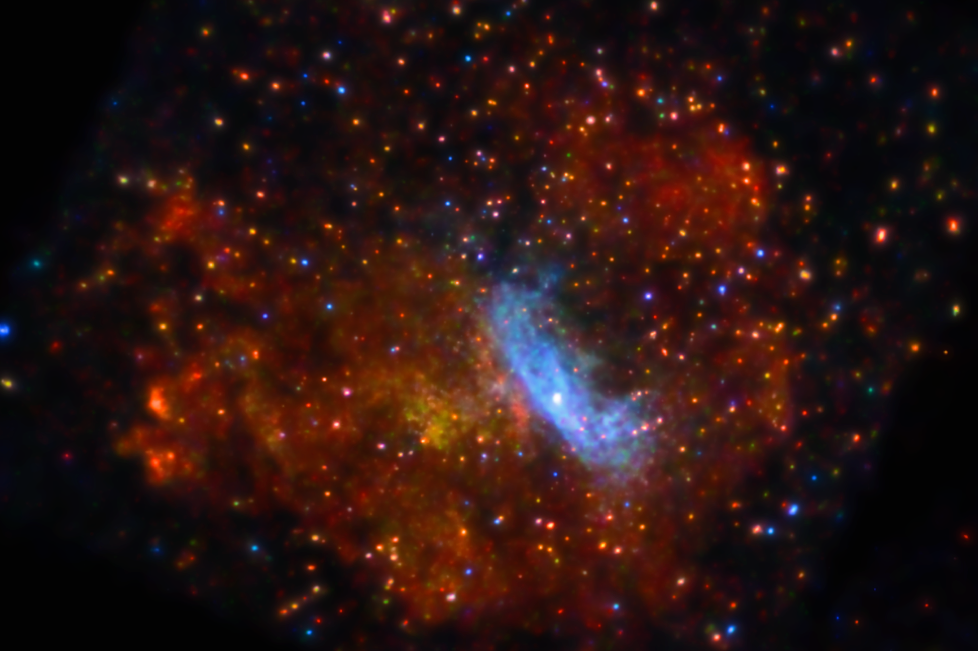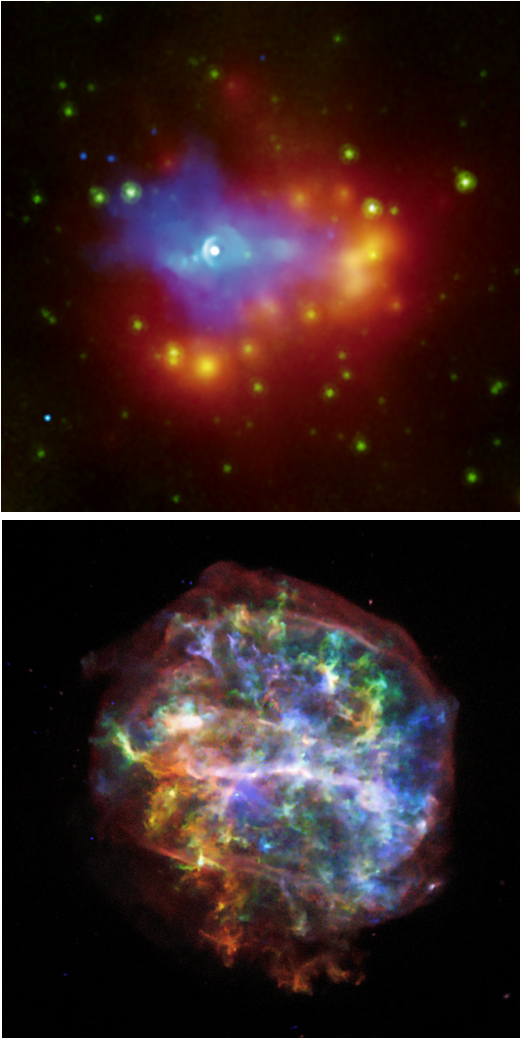The Explosive Aftermaths of Stars
Supernova Remnants
 In the collapse of a massive star, or the thermonuclear ignition
of a white dwarf core prompted by either accretion or merger with
another white dwarf, the resulting supernova explosion expels a
solar mass or more of material enriched in heavy elements synthesized
during the stellar evolution and explosive nucleosynthesis. The
expelled ejecta drive a collisionless shock into the surrounding
medium, creating a hot shell of ISM/CSM material - the supernova
remnant (SNR). As this blast wave slows down due to the swept-up
material, the increased pressure drives a reverse shock into the
ejecta, heating these as well. This creates an inner shell with
abundances that reflect the composition of the stellar ejecta.
The density structure and composition of the material behind the
blast wave provides key information about the environment surrounding
the stellar progenitor, including possible modifications from winds
or mass ejection events, while the ejecta heated by the reverse
shock contain information about the progenitor and details
about the explosion mechanism. In addition, the rapid shocks
are capable of amplifying magnetic fields and accelerating
particles to extremely high energies, producing a significant
component of the Galactic cosmic rays.
In the collapse of a massive star, or the thermonuclear ignition
of a white dwarf core prompted by either accretion or merger with
another white dwarf, the resulting supernova explosion expels a
solar mass or more of material enriched in heavy elements synthesized
during the stellar evolution and explosive nucleosynthesis. The
expelled ejecta drive a collisionless shock into the surrounding
medium, creating a hot shell of ISM/CSM material - the supernova
remnant (SNR). As this blast wave slows down due to the swept-up
material, the increased pressure drives a reverse shock into the
ejecta, heating these as well. This creates an inner shell with
abundances that reflect the composition of the stellar ejecta.
The density structure and composition of the material behind the
blast wave provides key information about the environment surrounding
the stellar progenitor, including possible modifications from winds
or mass ejection events, while the ejecta heated by the reverse
shock contain information about the progenitor and details
about the explosion mechanism. In addition, the rapid shocks
are capable of amplifying magnetic fields and accelerating
particles to extremely high energies, producing a significant
component of the Galactic cosmic rays.
My research includes studies of the structure and composition
of SNRs, their ability to accelerate cosmic rays, and details
of their temperature and ionization structure that places
constraints on shock heating and temperature equilibration
between particle species in the postshock region. These studies
incorporate observations from across the electromagnetic
spectrum, but are particularly driven by spatially-resolved
spectral investigations of the X-ray emission from SNRs.

Supernovae from the collapse of massive stars ejecta most of the
stellar debris from the progenitor. However, the very central regions
often collapse to form an ultra-compact neutron star. Generally,
but perhaps not always, these neutron stars have extremely strong
magnetic fields and are spinning rapidly, resulting in high electric
potentials that accelerate particles and form beams of pulsed
emission as the star rotates. The magnetic and particle winds from
these pulsars expand into the SNR interior where they are confined
by the slower-moving ejecta, leaving an expanding magnetic bubble
filled with synchrotron-emitting particles in these so-called
composite SNRs. The confinement of these pulsar wind nebulae (PWNe)
by the surrounding ejecta defines an outer boundary condition; a
termination shock is formed in the far interior, where the pulsar
wind is decelerated to gradually match the nebular flow. Magnetic
confinement results in jet structures along the pulsar rotation
axis.
The emission and structure of PWNe offer the opportunity to study
the conversion of rotation into energetic outflows - a theme with
importance on many astrophysical scales, but for which the actual
spin-down and associated geometry of the wind structure can be
uniquely probed in PWNe. In its early evolution, the outer boundary
of a PWN drives a shock into the innermost SNR ejecta, providing
a direct glimpse at the material formed closest to the core of
the explosion.
As the PWN evolves, the SNR reverse shock eventually disrupts the
PWN, modifying the energy evolution its relativistic particles,
and potentially providing paths for escape. Because most pulsars
are born with high velocities imparted by kicks in the explosion,
they eventually escape their SNRs, with their winds subsequently
confined by pressure from their motion through the ISM. While
much fainter at these ages, the absence of the SNR can provide
the ability to discern details of the PWN structure in its
innermost regions.
My research involves studies of PWNe at all evolutionary stages
though multiwavelength observations and hydrodynamical modeling.
While many young neutron stars have the properties of the pulsars
described above, X-ray observations of the young Cas A SNR revealed
a central star whose properties are vastly different. Their are no
detectable pulsations and there is no evident wind nebula. Subsequent
observations have revealed similar neutron stars in other systems.
Meanwhile, other SNRs reveal central neutron stars whose emission
greatly exceeds the power available from the observed spin down,
some displaying outbursts that indicate energy release from enormous
magnetic fields.
The demographics of neutron stars within SNRs provide our best
understanding of the birth properties of these objects, potentially
allowing for connections to the details of the supernova explosions
and the properties of the progenitor stars. My research in this
area has concentrated on searches for neutron stars in SNRs and on
measurements of the surface temperatures in comparison with models
for their cooling, which place important constraints on the inner
structure, for which the equation of state is poorly known due to
the extremely high densities.
Press
Our Research in the News

Articles
Podcasts
NASA/Chandra Image Releases
 In the collapse of a massive star, or the thermonuclear ignition
of a white dwarf core prompted by either accretion or merger with
another white dwarf, the resulting supernova explosion expels a
solar mass or more of material enriched in heavy elements synthesized
during the stellar evolution and explosive nucleosynthesis. The
expelled ejecta drive a collisionless shock into the surrounding
medium, creating a hot shell of ISM/CSM material - the supernova
remnant (SNR). As this blast wave slows down due to the swept-up
material, the increased pressure drives a reverse shock into the
ejecta, heating these as well. This creates an inner shell with
abundances that reflect the composition of the stellar ejecta.
The density structure and composition of the material behind the
blast wave provides key information about the environment surrounding
the stellar progenitor, including possible modifications from winds
or mass ejection events, while the ejecta heated by the reverse
shock contain information about the progenitor and details
about the explosion mechanism. In addition, the rapid shocks
are capable of amplifying magnetic fields and accelerating
particles to extremely high energies, producing a significant
component of the Galactic cosmic rays.
In the collapse of a massive star, or the thermonuclear ignition
of a white dwarf core prompted by either accretion or merger with
another white dwarf, the resulting supernova explosion expels a
solar mass or more of material enriched in heavy elements synthesized
during the stellar evolution and explosive nucleosynthesis. The
expelled ejecta drive a collisionless shock into the surrounding
medium, creating a hot shell of ISM/CSM material - the supernova
remnant (SNR). As this blast wave slows down due to the swept-up
material, the increased pressure drives a reverse shock into the
ejecta, heating these as well. This creates an inner shell with
abundances that reflect the composition of the stellar ejecta.
The density structure and composition of the material behind the
blast wave provides key information about the environment surrounding
the stellar progenitor, including possible modifications from winds
or mass ejection events, while the ejecta heated by the reverse
shock contain information about the progenitor and details
about the explosion mechanism. In addition, the rapid shocks
are capable of amplifying magnetic fields and accelerating
particles to extremely high energies, producing a significant
component of the Galactic cosmic rays.

